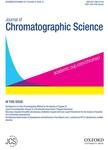版权所有:内蒙古大学图书馆 技术提供:维普资讯• 智图
内蒙古自治区呼和浩特市赛罕区大学西街235号 邮编: 010021

作者机构:Univ Macau Inst Chinese Med Sci State Key Lab Qual Res Chinese Med Macau Peoples R China Jinan Univ Atmospher Environm Inst Safety & Pollut Control Guangzhou Guangdong Peoples R China Guangdong Pharmaceut Univ Coll Pharm Guangzhou 510006 Guangdong Peoples R China
出 版 物:《JOURNAL OF CHROMATOGRAPHIC SCIENCE》 (色谱科学杂志)
年 卷 期:2019年第57卷第1期
页 面:9-16页
核心收录:
学科分类:0710[理学-生物学] 081704[工学-应用化学] 07[理学] 08[工学] 0817[工学-化学工程与技术] 070302[理学-分析化学] 0703[理学-化学]
基 金:Research Committee of the University of Macau [MYRG2016-00042-ICMS-QRCM]
主 题:LIQUID chromatography-mass spectrometry OSTEOPOROSIS diagnosis METABOLOMICS COMPUTER algorithms ACCURACY
摘 要:Retention time (RT) shifts are inevitable in liquid chromatography-mass spectrometry (LC-MS)-based metabolomics studies. RT alignment, aligning peaks originating from the same feature to an identical RT, is a necessary step prior to multivariate data analysis. Many RT alignment software packages and various algorithms have been developed. In the present study, a simple method for peak alignment was proposed using relative RT related to an inherent peak in the chromatogram, and its performance on RT alignment in untargeted metabolomics was evaluated using an LC-MS dataset acquired from plasma samples from osteoporotic rats, and compared with the common MarkerLynx XS method using different RT window. RT alignment accuracy and relative standard deviation (RSD) value of the intensity of 79 selected ions in a chromatogram were employed to assess the alignment effectiveness of Method I (0.2 RT window), Method II (0.5 RT window) and Method III (relative RT). The overall RT alignment accuracy of these three methods was 67.7%, 77.2% and 90.9%, and 44.3%, 72.2% and 82.3% of the ions had intensity RSD values 30%, respectively. The results demonstrated that Method III using relative RT significantly reduced the influence caused by RT shifts in LC-MS-based metabolomics. Furthermore, Method I and Method III were applied to discover plasma biomarkers for osteoporosis in rats. Thirteen and nineteen ions were selected as potential biomarkers, respectively. Among them, only eight common ions were found, which demonstrated that different sets of biomarkers were obtained using those two RT alignment methods. The relative RT method exhibited fewer missing values, a lower RSD of peak intensity and better performance in pattern recognition, thereby showing the great potential in future metabolomics studies.